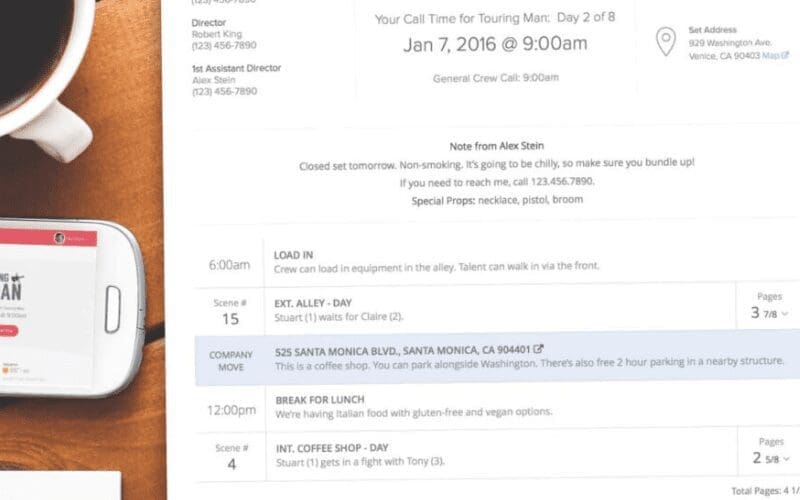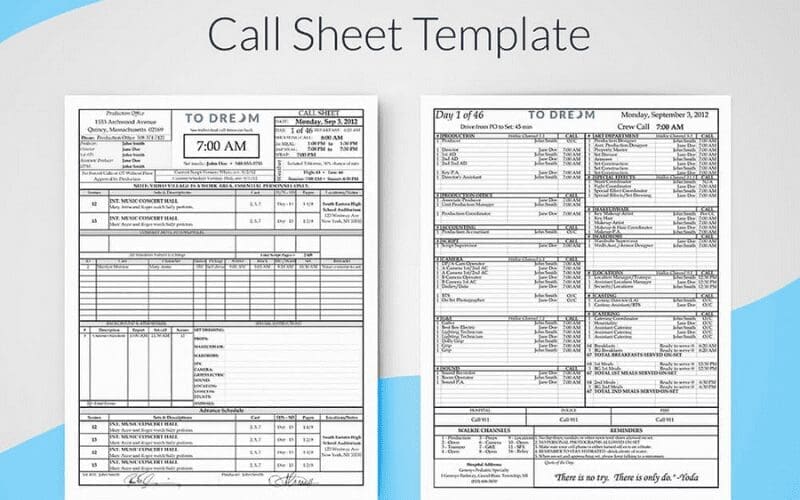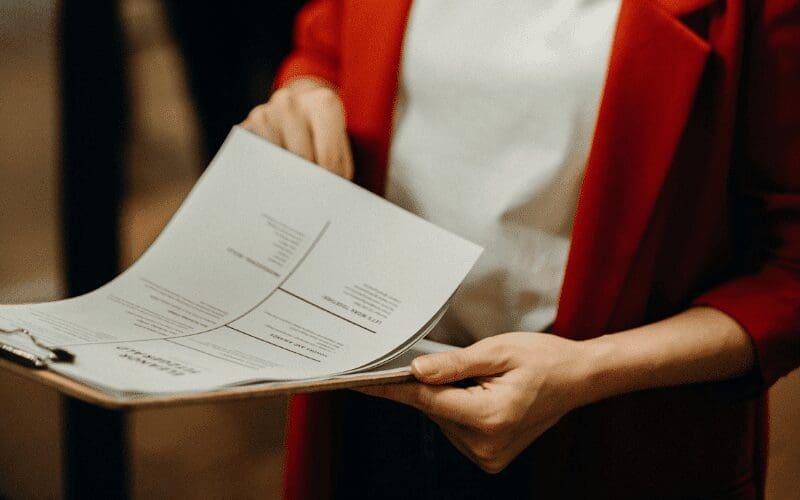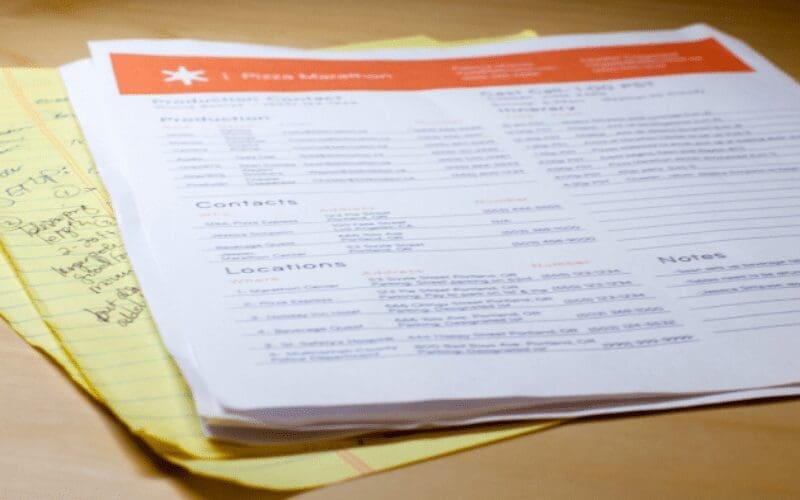If you’re working anywhere near a film or TV production, ‘call sheet’ is one of those buzz words you probably hear a lot. But what is a call sheet and what do productions need it for?

A call sheet is a schedule for the day on set that every crew and cast member can refer to. Each shoot day calls for a different call sheet and includes many different details.
If you were wondering what a call sheet is used for, then you have come to the right place! Stay tuned for everything you need to know.
Why Are Call Sheets Important?

Call sheets are essential to make sure each cast and crew member knows what’s expected of them throughout the day.
Even the smallest, low-budget shoot that has more than two people would require a level of coordination.
Imagine multiplying that effort ten, twenty, or a hundred times with a high-end production. Let’s say you’re a runner who needs to chase up the costume designer for a fitting. How do you find them? Or, maybe you’re making your way to set and can’t find the building.
A movie call sheet allows for a reference document that is easy to access and everyone on set is familiar with. Thanks to compartmentalisation, it makes information easy to spot at a first glance.
This way, if you’re looking for a specific person, you can check their call time and access their contact number. It minimises the room for error and makes sure everyone is provided with the same amount of information.
This also means there is very little room for excuses if someone fails to do something that is clearly indicated on the call sheet. Everyone knows to expect call sheets before the shoot and to refer to them before asking for additional information, in order to minimise disruptions on set.
What Should A Call Sheet Include?

A call sheet should, in brief, include everything that might be useful for planning out the shoot day.
This includes, but is not limited to, how many scenes are planned, the time of arrival for everyone, the contact details for the crew, how to get to the locations or the closest hospital – you never know!
Looking For A Production Call Sheet Template?

Fortunately, there are plenty of free templates out there ready to be downloaded and customised.
Some of the most accessible ones are from Topsheet, Celtx, and StudioBinder.
Although each call sheet example might vary slightly, the top banner will usually include the name of the production, company details, the producer and director’s points of contact, the call time, a brief overview of key times (e.g. lunch), and any urgent or special messages.
Moving down, you should find a shooting breakdown for each scene planned, which part of the screenplay they’re from, a brief description of the contents, and the location/smaller details.
Then, cast details. Actors’ names, their character, their call time, and, possibly, a breakdown of their schedule – such as their pick-up time (if production is covering their transportation to set). As well as the time they need to spend in Hair & Makeup, and any other occasional detail before they step on set.
Crew details are similar – names, role, and call time. Not forgetting their contact numbers, especially when it comes to Heads of Department.
This structure recurs quite often because it offers reliability. If a member of the crew is in a rush to learn what time they specifically need to be on set, they know to scroll to the end of the page.
What To Do When You’re In Charge Of A Call Sheet

If you have to make a call sheet, there are a few tips that can make your life easier.
Contact The Crew
Send an email around to the crew and ask if there’s anything specific they want you to keep an eye out for.
This is so you can collect requests and have them in mind when approaching the call sheet.
Plan In Advance
Plan well in advance and double check the timings.
You don’t want to have people waiting around, nor do you want the actors to still be in makeup when they should be on set.
Leave some room for contingence and emergencies.
Try to send out the call sheets at least 5-10 hours in advance so people can plan accordingly. Make sure you’ve cleared it with the producer and director beforehand.
Use The Correct Format
Also, always send the file in PDF to maintain the format and make sure it can easily be opened from any device.
Additionally, use hyperlinks to re-direct people to Google Maps or other apps that might come in handy.
Make phone numbers clickable so they’re easier to dial straight from the call sheet.
Furthermore, do not send more than one call sheet at a time – they can get mixed up and cause confusion.
Label the files accordingly (e.g. month + day + year, such as CALL_SHEEET_AUGUST_20_2021) so they can be traceable.
Keep A Copy
Keep an editable copy of the main template as most things will be copy and pasted from day to day.
Also, be sure to keep a copy of each daily sheet you send out. Dedicating a folder to the specific production is probably the best way to keep all the files organised.
Call Sheet Terminology

Since call sheets are so common and need to be as immediate as possible, there is certain terminology that is used time and time again.
In order to understand call sheets, you need to understand what they’re asking you. Let’s go through some of the most common abbreviations:
D/N
This means Day or Night.
It is used in the shooting schedule to indicate the time of day of a specific scene.
I/E
I/E means Interior or Exterior.
This is used in the shooting schedule to indicate the location of a specific scene.
BG
This means Background
It is used in the cast section to indicate that a certain actor plays a background/extra role and does not need to be in focus.
H/M/W
H/M/W means Hair/Makeup/Wardrobe.
This can be a column in the cast section to indicate the time an actor has to spend in these departments to get ready for set.
SW/W/WF/SWF
This means Start Work, Work, Work Finish, Start Work Finish.
These are used in the cast section to indicate if it is an actor’s first, consecutive or last day on set. SWF is used when an actor starts and finishes the role on the same day.
1/8
1/8 means eight of a page.
This is used in the shooting schedule to indicate the amount of script covered with a certain scene. 1/8 is about six lines.
The number can obviously vary depending on how extensive the scene is, so for example 8/8 will be about 48 lines of the script.
Summary – What Is A Call Sheet

Music Gateway & Film Licensing
Now that you know everything about call sheets, it’s time to put your organisational skills to the test!
Why not check out some more of our articles on a film production? We have guides such as, How To Become A Filmmaker In 4 Easy Steps, How To Become A Screenwriter and A Guide To Film Crew Roles.
If you are interested in the crossover between music and film, check out our article on music supervisors.
Also, please use this link to get in touch with us to discuss any opportunities such as Sync Licensing, Music Licensing, Music Clearance, Sync Libraries or Music Libraries, etc., you may want to take further.
You can book a call with Sam – Head of Sync Licensing – as a potential lead. We are always happy to talk to musicians like you. Please do get in touch.










